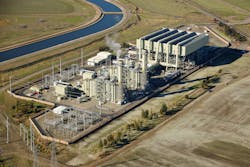Turbine Retrofit Reduces Hot Startup Time, Increases Revenues
Any competition runner will tell you that being the fastest off the block is a big boost if you want to be the first to break the tape at the finish line. The Middle River Power plant in Tracy, Calif., took the same approach to producing megawatts of additional power more quickly. The plant’s combustion turbine purge credit retrofit project, managed by Emerson, reduced the plant’s hot startup time by 30%. As a result, it’s expected to generate an additional $170,000 in annual revenue.
A combined-cycle power plant, like Middle River Power’s Tracy plant, combines two thermodynamic cycles to improve the overall efficiency of gas-fired generation. The first cycle (Brayton) is completed in the gas turbine engine. The resulting thermal mass in the exhaust, which might otherwise be vented into the atmosphere, is captured in a heat exchanger called a heat recovery steam generator (HRSG) where steam is produced and sent to a steam turbine (Rankine Cycle) to produce many more megawatts per unit of fuel burned with a significantly reduced heat rate.
The Tracy plant, located 80 miles southeast of San Francisco, is owned by Middle River Power LLC and operated by NAES Corporation. The retrofit project was initiated in response to fluctuations in renewable energy generation, which was causing the 323MW, 2x1 combined cycle plant to start frequently—typically 250 to 300 times per year. Wind and solar assets are typically placed into the power grid whenever they are available, but since they are intermittent, power plants are cycled in to balance the grid.
“Many combined cycle plants were designed for baseload or traditional generation. Cyclic operation increases the thermal stresses on plant equipment, which can lead to premature failures and forced outages,” explains Emerson’s Brett Benson. “Market changes necessitate the need to bring units online faster to balance the variability of renewable, intermittent energy sources. The ability to rapidly bring a unit online can mean the difference between being dispatched or left idle by the system operator.”
Making the change
Unless it is addressed, cycling can both reduce unit availability and increase costs. According to the U.S. National Renewable Energy Laboratory, “A major root cause of increased operations and maintenance costs for many fossil units is cycling.”
Prior to the retrofit project, the gas-fired Tracy plant was required to perform a 20-minute, fresh air pre-start purge cycle to remove potentially explosive residual fuels from the combustion system. The purge cycle extended overall startup times, putting the plant at greater risk of a delayed or failed start and missing its power purchase agreement (PPA) dispatch obligations, which could potentially trigger substantial financial penalties.
To reduce that risk, NAES took advantage of a change to the National Fire Protection Association’s “NFPA 85: Boiler and Combustion Systems Hazard Code,” which gave them the option to eliminate the pre-start purge by modifying fuel and monitoring systems. Emerson’s turnkey project scope included mechanical, electrical, and control system design, as well as installation and commissioning.
While replacing steam turbine controls and the excitation system at the Tracy plant with its Ovation distributed control system technology, Emerson also made National Fire Protection Association-compliant mechanical modifications to the fuel train in addition to related changes to the combustion turbine and duct burner control logic.
“[The] Tracy [plant] has seen immediate results following the implementation of the purge credit project, most notably significantly reduced startup time. Emerson’s technology and engineering resources got this project across the line for us, and we are extremely pleased with the results,” says Nick van Haeften, maintenance manager, NAES Corporation.
Additional benefits
Reducing the plant’s startup time may also help the Tracy plant avoid the expense of PPA failed-start penalties, which can exceed $300,000 per incident. Within the first two weeks after the project was completed, one failed start was avoided due to the ability to re-start after a trip and still meet the dispatch.
Other expected economic and operational benefits include eliminating the 20-minute purge of ambient temperature air through the turbine and reducing the thermal stress on the heat recovery steam generation. This is expected to extend the life of the unit by deferring maintenance costs for three to six years, which is beyond the timeframe of the utility’s current PPA. All told, this project is expected to result in a return on investment in only two to three years.
“Today’s power market is more competitive than ever,” says Bob Yeager, president of Emerson’s power and water business. “NAES is a forward-thinking organization that recognized how the purge credit can boost reliability and revenue, thereby putting the Tracy plant in an excellent position to capitalize on future market opportunities.”
About the Author
Jeanne Schweder
Contributing Editor, Automation World

Leaders relevant to this article:
